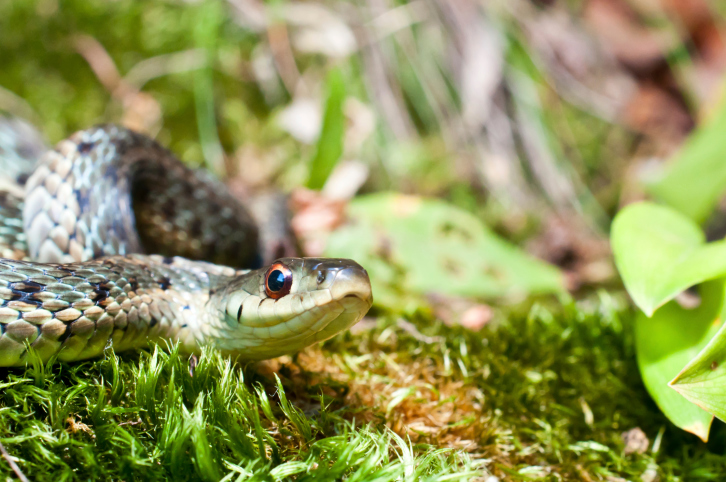View from the Garden: A Snake in the Garden of East End

Recently, we were cleaning the wild vegetation behind a client’s fence. It was a small area that had not been turned into lawn or garden but left on the edge of the property. I was removing fallen dead branches and tangles of briar and bittersweet when my co-worker began to shriek, “Ooh, ooh, ooh!” He rarely shrieks, but when he does, I know he has found a snake.
And sure enough, after looking closely, I saw a garter snake camouflaged against a log…there it was…a sweet little thing, sunning itself. It left when it saw us. Most snakes are poisonous where my co-worker comes from and he is afraid of all snakes and wants to kill them. After working together for many years, I have convinced him, that in this area, they should be left to run away.
The snakes we see in our garden and the areas surrounding them are usually garter snakes; harmless and non-venomous. They have three yellow stripes with checks between the stripes and grow to be 2.5 to 4 feet. We don’t see the big ones in our gardens, as there’s not enough food to sustain them. I have never seen one that is larger than 12” and since they are very thin, they don’t even look that long. They can swim but not climb. They do not lay eggs but deliver their babies live. Up to 50 in each litter, that are born able to take care of themselves.
If cornered with no escape, or agitated, they will bite, which could leave bacteria in the punctures of the bite. Bites should be seen by a medical professional. Don’t corner or agitate them! Leave them alone and teach children not to tease then or try to catch them. Don’t let dogs try to catch them or play with them. They do not make good pets and if left alone they will quickly slither away.
I don’t like snakes, not even garter snakes, but I’m happy to see them in the garden. Their presence indicates a healthy ecosystem with an extensive number of assorted “critters.” (Toads indicate the same and I do like them!)
Garter snakes are very beneficial in the garden. They eat mostly insects but also some of the less desirable garden critters like slugs, snails, voles and white-footed mice (a major vector for Lyme disease.)
Like all cold-blooded animals, garter snakes hibernate in winter, often with other snakes in mammal tunnels. (Do they hibernate with next spring’s food, I wonder?) They are one of the first snakes to emerge in spring and can be seen, when not hunting, basking in a sunny spot that is usually close to a protected place of escape.
They like to live near water or in moist places. I work in a garden that has a lotus pond with a stone surround. A garter snake has lived in that stonewall for the seven years that I have worked there. Of course, I don’t know if it is the same one but each spring I feel like I’m seeing an old friend.
If you just can’t stand the idea of snakes on your property, there are some things you can do to discourage them. Cut your grass often (but not too short). Leave no long grass against any building. Keep woodpiles well away from the house. Disassemble any large rock piles. Trim bushes and shrubs so they have no low-lying branches. Keep garbage contained so it doesn’t attract rodents. Screen places where mice or squirrels can hide, like under porches and decks or in your garage. Snake repellant is not very effective.
If, however, you do see a garter snake, try to accept that it’s a sign of health in your garden. It likes you much less than you like it and will quickly disappear. It’s totally passive and wishes no harm to anything other than its food.
Jeanelle Myers is a professional gardener, landscaper and consultant. For gardening discussion you can call her at 631-434-5067. jeanellemyersfinegardening.com



